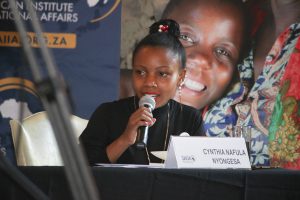On October 25th– 26th 2017, youth from across Africa gathered at the South African Institute of International Affairs at the University of the Witwatersrand in Johannesburg, South Africa. The purpose of this workshop was to get young people to add their voice to what is known as the UNICEF Generation 2030 2.0 report on the future of African children. This saw young people from Kenya, South Africa, Mali, Malawi, Nigeria, Zimbabwe, Mozambique and Côte d’Ivoire come together to share what policies and projects are currently being used in their countries to improve the lives of children and youth.

Youth delegates listening keenly
Many ideas came up and we also discussed what challenges and gaps need to be resolved in our individual countries. Every country faces its own challenges and therefore it is important for all stakeholders to concentrate on the uniqueness of their countries. The youth workshop was followed by a press launch on the 26th of October where we as African youth presented our resolution to world leaders. Our key focus areas included health, education, climate change, economic growth and peace and security.

Joseph Ngochi from Kenya during the launch
The report defines Demographic dividend as the ‘economic growth that can be achieved by having proportionally more working age people as a share of the population.’ It is important to note that this window of opportunity tends to shift in different countries. This is why it is important to critically focus on how Sustainable Development Goals can be achieved. These goals were adopted in 2015 and hence all stakeholders must participate. This is why public private partnerships are important.

David Anthony addressing the public and the media during the launch
According to the report, many African countries are experiencing an increasing child population. This is due to the high fertility rates. One of the key discussions we had was the sad situation we have in many schools where many students lack teachers and books. This means it is very difficult to improve the literacy levels in many countries. The report notes that more than 5.8 million additional teachers are required to strike a balance between pupils and teachers. It is important to note that child mortality rates have dropped in Africa with the statistics indicating that it has moved from 1 in 6 in [1990] to 1 in 14 in [2016].

Credit: UNICEF Kenya
As we continued to look at the statistics, I could not fail to note the efforts being made in my country Kenya to improve the sanitation levels especially for children under five. A campaign dubbed #HelpAChildReach5 , run by Lifebuoy with its brand ambassador Janet Mbugua has seen many children and parents being educated on the importance of keeping hands clean. This entails washing hands before eating and after visiting the toilets. This aims to help more children reach five years of age as a result of keeping off hygiene related diseases.

Speaking for Kenya
It is no doubt that as we think about investment, we must also focus on child protection. In my country Kenya, UNICEF launched a campaign called #EndViolence. This aims to protect children against violence and especially cyber bullying. Many children are at risk of defilement and especially from people who are close to them. Child protection should therefore be a priority to many organisations and families.
My interview with David Anthony who is the head of chief policy analysis also sheds some light into the information that can be gathered from the full report. Here is an excerpt:

David Antony breaking down the report
‘We started this report in 2014 when we had the first edition. That is when we realised that roughly a third of all children would be African by the year 2050. We wanted to explore what that meant. This kind of policy analysis allows us to think about what we are currently doing for the children. We needed people to understand where the population growth was coming from and what the consequences of the growth to factors such as health and education are. Our first report posed a challenge to policy makers on what needed to be done in terms on investment in children. We then realised that Africa’s child population was still increasing after the launch of the previous report. If the current trends persist, almost half of the world’s children will be African by the end of the 21st century. The question that we need to keep asking ourselves is, what do those children need to have a good and early start to life so that they are empowered? We have seen people from all over talking about the challenges and opportunities that Africa has of healthy, protected and empowered children. Many children in Africa don’t have this chance.

Generation 2030 delegates during the launch of the report
The main purpose of the Generation 2030 2.0 report therefore is to set the goals for a shift in the next few years. If that shift is made, by the mid century, many people will be lifted out of poverty and the per capita income will increase. We have seen a lot of progress in the last few years. A lot of governments are pushing forward agendas related to child education, water and sanitation and health. More young people are also coming out to find solutions to the challenges they face. The suggestions and policies they put out show the potential of young people. However, potential requires investment to be fulfilled whether you are in the sports, music, medicine or teaching sector. Africa must invest in its greatest asset which is the children and youth so as to reap a demographic dividend. The investment must start now. The demographic window of opportunity is drawing nearer for many countries. If countries have a strong foundation, then they can reap the benefits.’
